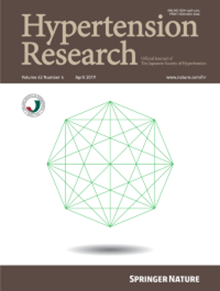Self-measurement of blood pressure at home using a cuff device for change in blood pressure levels: systematic review and meta-analysis
IF 4.3
2区 医学
Q1 PERIPHERAL VASCULAR DISEASE
引用次数: 0
Abstract
The effect of self-measurement of blood pressure (BP) at home (home BP measurement, HBPM) has been evaluated over the past decade. This meta-analysis included the latest studies to determine whether HBPM reduced BP (PROSPERO ID: CRD42023442225). PubMed, Cochrane Library Database, and IchuShi-Web were searched for randomized controlled trials after the year 2000 which demonstrated the effect of HBPM on BP change compared with usual care (UC). Overall, 65 articles (n = 21,053; 63 based on patients with hypertension) were included. The systolic/diastolic BP reduction was significantly greater in the HBPM than in the UC group by 3.27/1.61 mmHg (95% confidence intervals: 2.40–4.15/1.14–2.07) at the end of the intervention, and I2 values ≥ 46.7% suggested moderate-to-high heterogeneity. The funnel plots exhibited no notable publication bias (Egger’s test p ≥ 0.16). HBPM with co-interventions (such as telemonitoring) showed a stronger BP-lowering effect than without co-interventions while the effect of HBPM on BP change remained significant in the absence of co-interventions. HBPM was not associated with systolic BP changes when we combined the four studies that used a wrist cuff device for HBPM. The number of antihypertensive medications increased by 0.17 medications in the HBPM group compared with that in the UC group. There were no significant differences in body mass index changes or risk of severe adverse outcomes between the groups. Our results demonstrated a beneficial effect of HBPM in reducing BP, particularly when used in conjunction with telemonitoring or additional medical support and when employing upper-arm cuff devices.

使用袖带装置在家自我测量血压以改变血压水平:系统综述和荟萃分析。
过去十年间,人们对在家自我测量血压(BP)(家庭血压测量,HBPM)的效果进行了评估。本荟萃分析纳入了最新的研究,以确定 HBPM 是否能降低血压(PROSPERO ID:CRD42023442225)。我们在 PubMed、Cochrane Library Database 和 IchuShi-Web 上搜索了 2000 年之后的随机对照试验,这些试验证明了 HBPM 与常规护理 (UC) 相比对血压变化的影响。共纳入 65 篇文章(n = 21,053; 63 篇基于高血压患者)。在干预结束时,HBPM 组的收缩压/舒张压降幅明显高于 UC 组,分别为 3.27/1.61 mmHg(95% 置信区间:2.40-4.15/1.14-2.07),I2 值≥ 46.7% 表明存在中度至高度异质性。漏斗图显示没有明显的发表偏倚(Egger 检验 p ≥ 0.16)。与无联合干预措施的患者相比,有联合干预措施(如远程监测)的 HBPM 具有更强的降压效果,而在无联合干预措施的情况下,HBPM 对血压变化的影响仍然显著。当我们将四项使用腕式袖带装置进行 HBPM 的研究合并在一起时,HBPM 与收缩压变化无关。与 UC 组相比,HBPM 组的降压药物数量增加了 0.17 种。两组之间在体重指数变化或严重不良后果风险方面没有明显差异。我们的研究结果表明了 HBPM 在降低血压方面的有益效果,尤其是在与远程监控或额外的医疗支持结合使用以及使用上臂袖带装置时。
本文章由计算机程序翻译,如有差异,请以英文原文为准。
求助全文
约1分钟内获得全文
求助全文
来源期刊

Hypertension Research
医学-外周血管病
CiteScore
7.40
自引率
16.70%
发文量
249
审稿时长
3-8 weeks
期刊介绍:
Hypertension Research is the official publication of the Japanese Society of Hypertension. The journal publishes papers reporting original clinical and experimental research that contribute to the advancement of knowledge in the field of hypertension and related cardiovascular diseases. The journal publishes Review Articles, Articles, Correspondence and Comments.
 求助内容:
求助内容: 应助结果提醒方式:
应助结果提醒方式:


